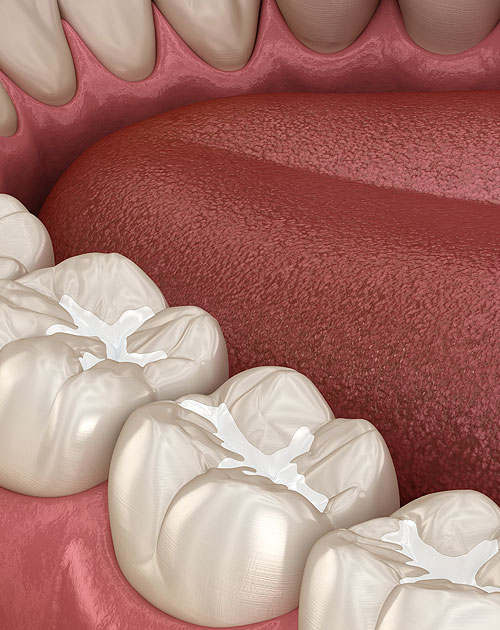Dental
SealantsLike going to this dental practice. I can usually get an appt within a week or so instead of having to book months in advance. Never have to wait long to get called back into the exam room. Everyone is always so friendly and respectful of the patient’s financial/personal situation.
- Therese T.
4.9


What are dental sealants?
You can prevent cavities by adequately sealing the pits and cracks of the teeth. A dental sealant is a thin, protective coating usually made from resin-plastic that fills and adheres to the chewing surface of your molars. Compared to fluoride alone, sealants are highly effective in preventing cavities on the chewing surfaces of molars.
Who can get dental sealants?
Sealing teeth as soon as they erupt into the mouth can prevent cavities from the very start, saving time, discomfort, and money in the long run. Therefore, sealants are usually placed in children and teenagers because tooth decay can begin as soon as teeth erupt, and most decay in kids appears on the upper or chewing surfaces of molars.
Since there is always a risk for developing cavities at any phase in life, adults are at high risk for decay, especially those with dry mouth & poor diet, but they can benefit from sealants, too. While adults and children can both benefit from sealants, it’s better to have them at an earlier age. Sealants can be put on baby molars or permanent molars. However, they are more cost-efficient when used on permanent teeth.
Give us a call to schedule your next appointment.
How do sealants
work?
Cavity-causing bacteria accumulate in the grooves and cracks of your teeth and feed on the sugar and food particles captured in your tooth. They create acids that eat the tooth structure and ultimately create holes, typically called cavities. It is where dental sealants come in: Sealants act as a thin plastic fence, keeping bacteria and food debris out of tooth crevices and stopping cavities from forming. They can also be used to stop the earlier stages of decay rather than putting a filling.
Applying a sealant is an effortless process. It doesn’t require an anesthetic, and it takes just a few minutes for your Gainesville dentist to apply the sealant to each tooth. The application procedure for dental sealants is as follows:
Gainesville dentist thoroughly cleans the teeth that are to be sealed.
Each tooth will be dried and isolated with cotton or another porous material.
A mild “etching” solution is applied to the teeth to roughen the chewing surfaces. The uneven surfaces will help the sealant bond to the teeth.
After a few seconds, the solution is washed off, and the tooth is dried again. Then, the sealant is painted into the holes and cracks of the tooth surface.
Some sealants solidify on their own in a minute or so. Others are “light-cured” and set quickly when the dentist exposes the sealant to the curing light.
Remember that multiple types of sealant materials are available, and may require a little grinding or wear after they are placed to ensure your bite is accurate.
Dental sealants can save your teeth from decay for many years. However, sealants can still get damaged or fall away. To restore the protecting shield and dodge cavities, missing or damaged sealants must be restored or replaced. For this reason, it is crucial to get regular oral check-ups where your Gainesville dentist can check the integrity of your dental sealants. If they are in questionable sickness, your dentist in Gainesville may reapply them.


